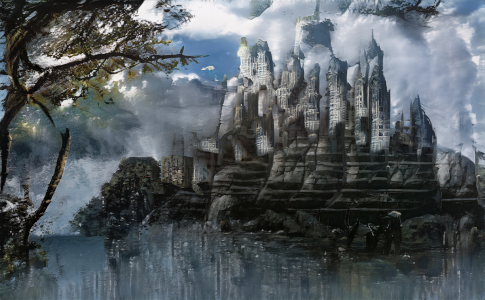Sylolume (sai-loh-ˈLOO-mey)
The many carts stood in a row outside the factory, waiting for their precious cargo of porcelain. The hay inside was dry and deep, excellent cushioning for the fragile wares. The craftsmen began to bring out the crates and load them into their appropriate vehicles. Aelrie spotted the Master of the workshop near the building. "Can I help?" she begged. The Master looked her up and down, "Go help your father with the books, this is guild work." Aelrie's face fell. That hadn't been what she'd meant. Would she ever be allowed to handle the porcelain, let alone be able to craft it?Sylolume is a city dedicated to one thing: the making of fine porcelain wares. Located along the Aman Serine in Glaerhiel, the city has access to many different clay and mineral deposits. It has been producing high-quality pottery and porcelain almost since its founding. Originally a small village of potters, Sylolume began to grow when a pair of them started experimenting with different minerals and heat combinations, attempting to create different glazes and finishes for their pottery. Quite by accident, they discovered the formula for porcelain ceramics. They and their fellow potters then began refining the discovery and how it could be used. Their wares gained popularity, and many other craftspeople came looking to learn the technique. Sylolume swelled into a large town within a few decades. As the town grew, guilds started to form around the craft, requiring long years of work, as well as loyalty, before learning the secrets of porcelain. Each guild had their own style, and each style was popular at one point or another. During the years of the Burhamli Empire, porcelain mainly had a regional appeal among the Elves of the subject Kingdom of Imizael. Many shipments of various porcelain wares, especially the current favorite of the time, yellow porcelain, were shipped to the Elven capital at Sale Nalore in Chauriel. Once the Burhamli Empire crumbled, and the Lazirican Dynasty overthrew Imizael, founding the Omaceran Empire, the city of Sylolume experienced its heyday. The guilds are believed to have reached the top of their craft during this time period, and the Laziricans claimed the sole right to Sylolume porcelain, for both the Emperor's use, as well as for diplomatic gifts and the like. The most recognizable patterns from this era involved designs painted in red and blue glaze on a pure white background. As The Withering swept across the Empire and beyond, Sylolume and the secrets of porcelain were almost lost. Some guilds lost over 80% of their membership, or more. Fearing their secrets would be lost forever, Guildmasters began writing down what they knew, for their families to be able to carry on after the disease ran its course. However, they were still jealous of their secrets, and often wrote these instructions down in coded languages that only fellow guildmembers and family would know. As a result, many of these secrets were lost to time, as The Withering took entire families and even guilds. The city itself was very nearly wiped out, ending up back as a struggling village amidst a mass of empty buildings. After The Withering, as the continent was recovering, an attempt was made to revive the porcelain trade in Sylolume. Folks from different guilds came together to share what they knew of the process, and a new, unified guild was created to preserve this knowledge. The porcelain they produced was considered subpar, compared to what they had been able to create, but it was still stronger and more beautiful than simple pottery. Today, Sylolume has recovered its losses and is once more a thriving city. Porcelain continues to be the central industry and trade, although it has never quite matched the glory it once had. The Unified Porcelain Makers' Guild controls the production and sale of porcelain goods, as well as who enters the guild. The Nindrol Elves are in command of the guild, and it is rare for them to allow an outsider elf into their ranks. Non-elves do not even have a chance. There have been complaints to the city council, but they have no say over guild business, and tend to be Nindrol Elves, themselves. Sylolume is still the name in porcelain, and collectors will pay great sums for pre-Withering pieces, particularly, when they can be unearthed whole. Many families in Glaehriel and Chauriel own pieces such as these as family heirlooms. It is a point of pride to own such a thing, for they are rare and beautiful creations.
Geography
The city of Sylolume is situated at the very border of Glaerhiel, along the Aman Serine river, about 20 miles east of where it is joined by the Ayal Esari. The city sits a little south of the river, itself, on a large, low hill, which helps prevent flooding. The banks all along this area have large pits dug in them, from centuries of pottery and porcelain making. Sylolume is divided into four districts: the Residential District, where about three-fourths of the citizens live, the Old District, another residential area located behind the Old Temple and home to much of Sylolume's unique architecture, the Artisans' District, where the porcelain workshops and other businesses reside, and the Market District, where shopkeepers and their families reside above their businesses.
Founding Date
2715 BW
Type
City
Population
7083
Inhabitant Demonym
Sylolumite
Owning Organization




Comments